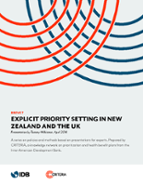Breve 7: Explicit Priority Setting in New Zealand and the UK
Date
Oct 2015
This Breve is based on a webinar presented by Tommy Wilkinson, Health Economics Advisor at NICE International, on April, 2014, to the members of CRITERIA, the Knowledge Network on Health Benefits Packages and Priority Setting in Health. Two prime examples of explicit priority setting in the healthcare space can be found in the United Kingdom and New Zealand. The UK's National Institute for Health and Care Excellence (NICE) and its achievements are recognized around the world. New Zealand's Pharmaceutical Management Agency (PHARMAC) has a similar remit to NICE, in that it determines funded access to pharmaceuticals and other technologies while operating within a range of different constraints and contexts. For many, PHARMAC also represents one of the world's most successful case studies in medical priority setting and pharmaceutical expenditure control.
The presentation and its resulting BREVE provide a perspective on the objectives, capacities and products of NICE2 and PHARMAC and explore the comparative advantages of each of these agencies. Specifically, it describes and compares the two agencies and the context in which they work; analyzes and compares their priority setting processes; and presents an overview of the types of Health Technology Assessment (HTA) conducted. Given the relative lack of information currently available in the literature about processes employed by PHARMAC, this policy brief will focus on PHARMAC in greater detail. For full information on NICE and PHARMAC, please refer to their websites www.nice.org.uk and www.pharmac.govt.nz, respectively.
The presentation and its resulting BREVE provide a perspective on the objectives, capacities and products of NICE2 and PHARMAC and explore the comparative advantages of each of these agencies. Specifically, it describes and compares the two agencies and the context in which they work; analyzes and compares their priority setting processes; and presents an overview of the types of Health Technology Assessment (HTA) conducted. Given the relative lack of information currently available in the literature about processes employed by PHARMAC, this policy brief will focus on PHARMAC in greater detail. For full information on NICE and PHARMAC, please refer to their websites www.nice.org.uk and www.pharmac.govt.nz, respectively.




